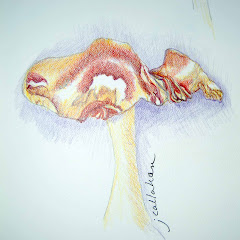Monday, April 23, 2012
Morea Lake State Park
I made a trip to Moreau Lake State Park this weekend, to see what changes spring has wrought in that lovely little corner of the world. Well, not so little, actually; I was reading an excellent article by Jack Freeman and Bob Goodwin, ADK (Adirondack Mountain Club) enthusiasts http://www.adk.org/ad_mag/moreau_park_hike.aspx and found out that Moreau Lake State Park (MLSP) is comprised of 4,200 acres! In 1998, the Open Space Institute purchased 3,200 acres of undeveloped land in Saratoga and Warren Counties, on either side of the Hudson River, from the Niagara Mohawk Corporation, and added it to the park’s previously existing 900 acres. The result is gorgeous, unspoiled, hiking trails that add breathtaking views, and have heightened the beauty and appeal of the park to many more nature enthusiasts.
Although the limits of the park are just south of majestic Adirondack Park (AP) in the Adirondack Mountains, which is made up of 6.1 million acres of publicly protected lands, the ADK publication committee was so impressed with the beautiful lands comprising MLSP, that they saw fit to include it in their new edition of the Adirondack Southern Region Trail Guide.
I found the lake and the environs quiet on Saturday, perhaps it was the forecast of heavy rains, but in the morning, though the skies were overcast, it was not enough to discourage exploring. While hiking around the lake, I was struck by the ubiquitous stands of Phragmites (Phragmites australis). The success of this plant is, in large part, due to the fact that it releases a chemical called Gallic acid, and when it is exposed to ultra-violet light, a second harmful toxin is produced: Mesoxalic acid. These two substances are destructive to other susceptible wetland plants, and as a result, it crowds out other, more beneficial, and productive, plants, such as cattails.
It spreads by horizontal runners, and can expand its ground by up to 16 feet per year. Its roots go very deep and strong, and as such it is very difficult to control. The most effective method found has been through controlled burning, but because of the depth and strength of these roots, the burns need to take place over two, to three, consecutive seasons, for one burn is not enough.
There were some other more hopeful signs of spring: apple blossoms on a wild apple tree, gill-over –the- ground, which was in abundance, and views of the lake, and the hills beyond, showed pale greens in evidence everywhere. I am sure these changes, and more, especially since the rain these past few days, will grow exponentially as we proceed into the season, and that is something to look forward to!
Thursday, April 19, 2012
A Season Unfolding








Yesterday, and again today, I got out in the kayak and took special note to see if the water level seemed to be changing. It did seem slightly higher, but there were signs everywhere of the dearth of water: the usually lovely green cattail shoots were all tinged at the tops with brown and yellow, like houseplants long neglected; and I saw a bank that held a mass of grass roots which just dangled helplessly two feet over the water.
I noticed two chewed-down trees, the work of beavers no doubt, and today I saw signs of fresh work, just since yesterday: not only were the tops of these young saplings lopped off, but today, when I came back, the bark, from the remaining stumps, had been stripped off. It was very interesting to see the chew marks on these trees, and to see that they were so fresh.
As I was drifting in my boat, I came upon a lone, Red-wing Blackbird (Agelaius phoenceus), a first-year male, as evidenced by his conspicuously-absent red shoulders, which appear in the second year of their life. The first year, the males are brown, like the females. When they begin to develop mature plumage, they turn black, and have just a hint of white feathers on their shoulders, where the red will eventually appear.
This one seemed a bit lost, he seemed to wander aimlessly, just hopping about, as though he wasn’t quite sure what he was looking for. And this is understandable, considering they leave their nest in as little as 11 days after hatching. This is, no doubt, due to the fact that the parents produce two to three clutches of eggs per season! I have always loved these birds because I live on the water, where they make their home (it is, after all, great protection against predators- both the water itself, and the dense stands of cattails, rushes and reeds make for good cover) and the sound of their shrill call is a sure sign that spring is around the bend.
According to Wikipedia, the males are very territorial, and will defend up to 10 females. But interestingly enough, the females will mate with other males, besides their “social mate” and will often lay clutches of mixed-paternity.
I also spotted a snapping turtle (Chelydra serpentina) which, I found out today, is the state reptile of New York! We grow them very large in Fish Creek; I read today in Wikipedia, that they only grow up to 20 inches, but I think that must not be accurate, because I have seen many an enormous snapping turtle, in my years here on the creek. They say a full grown turtle will weigh up to 35 pounds, but again, in captivity, they have been known to weigh as much as 75 pounds! Either way, they are formidable to meet. They have a reputation for being very fierce out of the water, and I have witnessed this myself. But they are usually quite eager to quickly retreat from human contact, and I have never once felt personally threatened by one. They are carnivores, and quite active hunters: they will eat pretty much anything that has the misfortune of fitting in their mouth: frogs, fish, snakes, birds, and even smaller turtles, are not safe around them if they are hungry. I’ve caught them sunning on the bank many times over the years, but they quickly slip into the water as soon as they detect your presence.
Some of the birds that I saw over the past two days were: green heron (got only the briefest glimpse of it, but seeing as I watched a family of them over the course of a whole summer, I know them by sight, quite well) belted kingfisher (I watched its dramatic dive-bomb into the lake to catch some prey, but it apparently missed its mark) also sparrows, robins, nuthatches, a pair of mallards and some mourning doves; and finally, I heard, but did not see, a pileated woodpecker, and a cardinal. In addition, I watched a lone Canadian Goose; as the male and female have almost identical plumage, I cannot say for sure its sex, but I felt that it was a male. I kept my distance, so as not to crowd him, or make him feel threatened in any way. He seemed to keep an eye on me, just to be sure, but finally, after ten minutes or so, he began to relax, and strutted down to the water, rather that just standing sentinel. All in all, it was a good week on Fish Creek!
Monday, April 16, 2012
Maiden Voyage







I cannot believe that it has been 13 months since I have blogged last! I guess I needed this gorgeous day to wake me out of my slumber! Although I very much appreciated the beauty of the day, it gave me an eerie feeling: today’s near-90 degree temperatures were strange enough, though it seems we’ve had quite a bit of strange and unusual weather: the least of which not being our exceptionally mild and dry winter. As a result, the water levels on Fish Creek (an outlet of Saratoga Lake) are lower than I have seen in all of my 30 years of living here!
As I sat in my kayak in Sucker Brook, an outlet of Fish Creek (usually, my favorite place to go when I am on the water, because it is so intimate and private, and where I have seen some very exciting ‘up close and personal’ looks at: muskrat, beaver, deer, mink, great blue herons, green herons, pileated woodpeckers, blue birds, sand cranes, and turtles; as well as a lovely variety of wild flowers; that it draws me back, day after day.) But today, the banks that normally are eye level, rose up above my head several feet. And when I came to the old train tressle bridge that crosses the brook (which has survived for over 100 years, when day trips to Saratoga Lake, from the city of Saratoga Springs, were all the rage for Victorian tourists) I could not go by, for there was not enough water for my kayak to pass. Last year at this time, I could not pass either, but for a very different reason: the water was too high – a difference of 6 feet!
At any rate, though most of the trees are still quite bare (except for the weeping willows which are mostly leafed-out) I saw many signs of spring, despite the low level of activity, and for that, I am grateful!
Subscribe to:
Comments (Atom)









